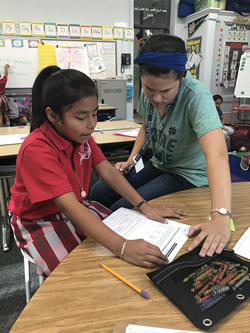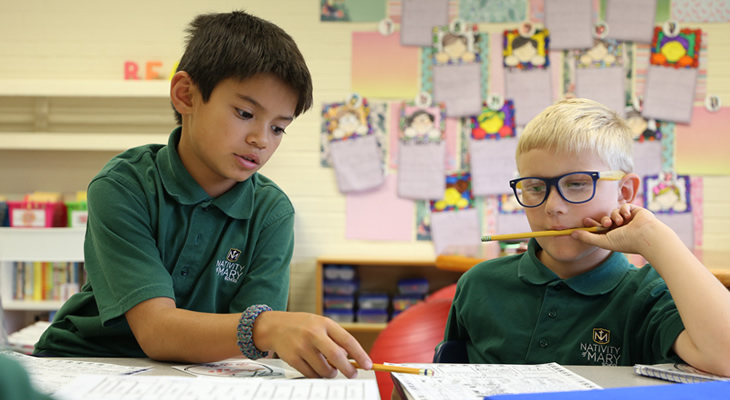What makes the Higher-Powered Learning Program unique?

Higher-Powered Learning is an initiative of the University of Notre Dame’s Alliance for Catholic Education. The Higher-Powered Learning team utilizes a blended-learning approach to personalize education for students and empower teachers with actionable data about student performance. This method combines technology and high-yield instructional practices to differentiate learning, ensuring each student receives an education that reflects their dignity as a unique child of God.
 What is Blended Learning?
What is Blended Learning?One of the most promising new initiatives in K–12 education is blended learning, a model of education in which students use adaptive, online software in classrooms to master material at levels that match their skills as teachers use the rich data from these programs to personalize their instruction and make targeted interventions. The “blend” in “blended learning” is the combination of the benefits of learning through adaptive software with the salient aspects of traditional schools to create an authentically new form of education.
Learn more about blended learning >>
Powered learning is “a form of learning in which students use adaptive software in a classroom setting to personalize their engagement with content, while teachers employ high-yield instructional practices and optimize their role by utilizing data from the software in regular and thoughtful ways to make targeted interventions” (Wills, 2015).
The approach of the Higher-Powered Learning Program is to give students the ability to work at their just-right reading and math levels while equipping teachers and leaders with actionable data in order to make targeted interventions and smart ability groupings. This empowerment, implemented in the context of a Catholic school, is what we call “Higher-Powered Learning.”

Though we have not replaced the term “blended learning” with “powered learning” in our own work or discourse, we think that the concept of “powered learning” emphasizes the critical features of the blended-learning programs we create and promote. In our schools, adaptive software programs are intended to empower teachers and students and to drive more personalized, higher-order learning than would occur otherwise.
Learn more about the Higher-Powered Learning Program >>

The Alliance for Catholic Education’s (ACE’s) Higher-Powered Learning Program is a three-year program guiding teachers and school leaders through the implementation of excellent and sustainable blended-learning programs. This cohort-based model includes three to five schools from a diocese (read more about how we select our schools) and each school creates a Blended Learning Advancement and Strategy Team (BLAST), comprised of the school leader(s) and three to four teachers, to lead the higher-powered learning initiative at their schools. BLAST members embark on a path that includes four to seven days of professional development each year as well as coaching calls, professional learning communities, and guided projects throughout the course of the program. This intensive professional development and support empowers the BLASTs to implement school-wide blended-learning programs by the end of the program.
Thanks to the generosity of the GHR Foundation and Bush Foundation, five schools from the Archdiocese of St. Paul and Minneapolis comprise the first cohort of the Higher-Powered Learning Program, which began in 2018.
Learn more about the Higher-Powered Learning Program >>
The Higher-Powered Learning team supports the Notre Dame ACE Academies by providing professional development on blended and personalized learning, data-informed instruction, and using technology in the classroom. The team supports several blended-learning teachers in Holy Angels Catholic School, Central Catholic School, and St. Philip Neri Catholic School.
Read more about our work with the Notre Dame ACE Academies on the Higher-Powered Learning blog >>

The Alliance for Catholic Education’s (ACE’s) Higher-Powered Learning Program is a three-year program guiding teachers and school leaders through the implementation of excellent and sustainable blended-learning programs. Three to five schools from a diocese are selected to participate as a cohort and each school creates a Blended Learning Advancement and Strategy Team (BLAST), comprised of the school leader(s) and two to four teachers. The BLAST teams then lead the higher-powered learning initiative at their schools.
For BLAST members, the Higher-Powered Learning Program includes 4-7 days of professional development each year as well as coaching calls, professional learning communities, and guided projects throughout the course of the program. This intensive professional development and support empowers the BLASTs to implement blended learning school-wide by the conclusion of this three-year program.
 This program is intentionally designed to develop the internal capacity at each school by empowering teachers and school leaders to make these significant changes while also ensuring that they receive appropriate ongoing support to successfully improve teaching and learning with technology.
This program is intentionally designed to develop the internal capacity at each school by empowering teachers and school leaders to make these significant changes while also ensuring that they receive appropriate ongoing support to successfully improve teaching and learning with technology.
We believe in the efficacy of this implementation model for three key reasons.
Thanks to the generosity of the GHR Foundation and the Bush Foundation, five schools in the Archdiocese of St. Paul and Minneapolis comprise the first cohort of the Higher-Powered Learning Program:

If you have any questions about the program or our website, please contact our team at . We look forward to hearing from you!